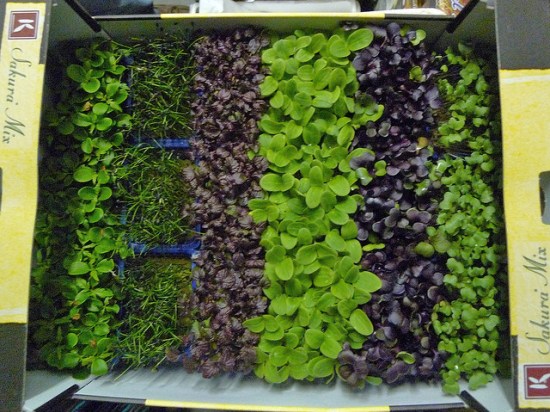Not eating–or growing–microgreens yet? Then you’re missing out on a seriously easy way to increase your nutrient intake. Researchers from the U.S. Department of Agriculture and the University of Maryland found that leaves from microgreens had more nutrients than the mature leaves of the same plants. Better yet? You can grow your own microgreens. Let’s take a look at what they are and how you can introduce them to your own garden… and diet.
WHAT ARE MICROGREENS?
Microgreens are the first true leaves produced from a seedling, often under 14 days. These greens are young and quite short, only reaching about 1-3 inches in height. Leave those alone and you’ll get a full-fledged leafy plant. You may even be more familiar with microgreens than you know: restaurants increasingly use them to decorate salads and soups. But you probably didn’t know they were so healthy!
BUT MICROGREENS SOUND LIKE SPROUTS, DON’T THEY?
There are fundamental differences. Sprouts are seeds germinated in water long enough for them to form roots, a stem, and underdeveloped leaves. Microgreens require soil and sunlight. The time difference is also telling: sprouts take about 48 hours while microgreens take 7-14 days.
NUTRITIONAL BENEFITS OF MICROGREENS
Microgreens are perfect toppers to your meals and will add, but not replace, nutritional value. Nutrients vary by plant but most include large amounts of vitamins C and E and beta carotene. Researchers found that red cabbage contains the highest amount of vitamin C (forty times the amount in regular red cabbage!) and six times more vitamin C. Green daikon radish microgreens contain more vitamin E than any other microgreens. Cilantro microgreens contain three times more beta-carotene than mature cilantro.
Overall, the same nutritional rule applies to microgreens: the more colorful the crop, the more nutrients it contains.
WHAT ARE SOME POPULAR MICROGREENS?
You might find packages of the following pricey produce in your local market:
- Arugula
- Cilantro
- Basil
- Kale
- Endive
- Radish greens
- Watercress
- Cabbage
- Peas
- Spinach
- Beet greens
- Lettuce
HOW DO I GROW MICROGREENS?
If your first thought was, “I’m not paying for that!” then we’re right there with you. You have two options: buy a kit or start from scratch. If you choose not to buy a kit, you can start your microgreens gardening experience indoors by using a reusable or disposable plastic food container. You can be creative: use a plastic juice carton, Styrofoam cup, or the plastic container strawberries are packaged in.
Create drainage holes and fill with seed-starting mix and your choice of seed. Sprinkle an additional layer of mix over the seeds (seed packets will indicate planting depth) and mist with a spray bottle. You’ll want to water whenever the soil looks dry (at least daily) and provide sunlight.
Microgreens can also be grown in your outdoor garden. Due to the size of the greens, a few extra considerations are necessary. Be sure your garden soil is loose and weed-free prior to planting. Water when the soil is dry, but do your best to create a gentle stream so as to not bury the seeds deeper in soil. Seeds should be planted 1/8 to 1/4 of an inch apart, but in general, they don’t need much room since you will harvest early. No fertilizer needed.
Finally, microgreens can also be grown without soil, but because several seeds grow better in soil, we recommend that method.
WHEN DO I HARVEST MICROGREENS?
Microgreens are meant to be harvested when small, about 1-3 inches tall. A general harvesting timeline follows leaf growth: you’ll want to harvest when you see a second set of leaves appear. Simply snip with scissors above the soil level, or you can pull up entire clumps of greens (you cannot harvest more than once). Want to grow more? Leave the old roots in place and simply scatter additional seeds (via GardeningChannel).
If you like this idea, be sure to share it with your friends and inspire someone you know. Anything becomes possible with just a little inspiration…

